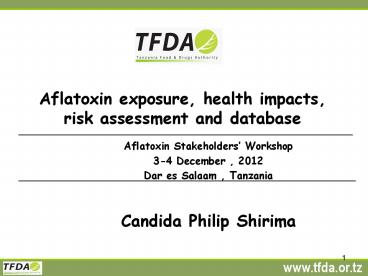Aflatoxin exposure, health impacts, risk assessment and database - PowerPoint PPT Presentation
1 / 15
Title:
Aflatoxin exposure, health impacts, risk assessment and database
Description:
Title: PowerPoint Presentation Author: Hiiti Sillo Last modified by: Candida Created Date: 7/26/2005 5:20:42 AM Document presentation format: On-screen Show (4:3) – PowerPoint PPT presentation
Number of Views:447
Avg rating:3.0/5.0
Title: Aflatoxin exposure, health impacts, risk assessment and database
1
Aflatoxin exposure, health impacts, risk
assessment and database
- Aflatoxin Stakeholders Workshop
- 3-4 December , 2012
- Dar es Salaam , Tanzania
- Candida Philip Shirima
2
Aflatoxins
- They are toxic and fungal metabolites
- Produced (A. flavus, A. parasiticus and rare
A. nomius) - Types aflatoxins B1 (AFB1) and B2 (AFB2), (AFG1)
and G2 (AFG2). - Aflatoxin B1 occurs most frequently and is most
toxic and carcinogenic
3
Human exposure to aflatoxins
- Dietary exposure The main source of human
exposure to aflatoxins - Exposure is through consumption of aflatoxins
contaminated food. - Contamination of maize and groundnuts is of
particular concern- dietary staples including
children complementary foods. - The presence of aflatoxins metabolites in breast
milk (AFM1) provides main source of aflatoxins
exposure for lactating newborn infants and breast
feeding young children - Exposure from animal food products poultry
4
Toxicokinetics of aflatoxin
5
Aflatoxins exposure assessment
- Quantitative evaluation of the likely intake of
aflatoxin via food. - The extent of exposure to aflatoxins depends on
the level of the toxin in different foods and on
the level of consumption of those foods
6
Ways of assessing exposure to aflatoxins-1
- Food measurement
- 1.Use levels of aflatoxin contamination in food
and quantities of food consumption Probably daily
intake (PDI)
Aflatoxin Contamination in food (ng/gm)
Food consumption (gm/day)
Aflatoxins exposure (ng/kg-bw/day)
Body weight (Kg)
7
Ways of assessing exposure to aflatoxins-2
- Use of biomarkers of aflatoxin exposure
- Biomarkers are a measure of a cellular,
biochemical or molecular change in biological
media (human tissues, cells or fluids), which is
informative with respect to assessing an exposure - Use of biomarkers requires understanding of the
mechanisms of aflatoxin actions
8
Ways of assessing human exposure to aflatoxins-3
- Use of biomarkers of aflatoxin exposure
- Biomarkers of aflatoxin exposure include-
- Urinary aflatoxin metabolites, such as
AFB1-N7-guanine and AFM1 - AF-albumin in blood serum, DNA adducts
- AFM1 in breast milk
- These metabolites are well validated as
biomarkers of aflatoxin exposure.
9
Aflatoxin research work by TFDA
- Completed study
- Iringa, Kilimanjaro, Tabora and Mtwara
- Aflatoxin occurance 18 in maize
- Contamination level range 1 to 158 µg/kg
- Ongoing studies
- Iringa, Kilimanjaro and Tabora (TFDA Leeds
University) - -Use of biomarkers in the evaluation of dietary
exposure to aflatoxins and fumonisins among
young children. - -Association of children growth and exposure to
the mycotoxins - Hanang, Kilosa and Rungwe (TFDA and Ghent
University) - Strategies for reducing mycotoxins contamination
and exposure- - -Application of GPHP and dietary approaches
/diversification
10
Aflatoxins and health effects
- Aflatoxins are toxic in humans and animals
- Carcigonen AFB1 has been classified as a group 1
human carcinogen by the IARC (1993). - Associated with aflatoxicosis acute poisoning
which results in direct liver damage and
subsequent illness or death (Kenya in 2004) - The liver Target organ for both acute and
chronic aflatoxin toxicity - High aflatoxin exposure is associated with
impairment of child growth, particularly
stunting the underlying mechanisms are unclear
11
Aflatoxins and health effects
- Immune suppression effects
- Hepatopmegaly (liver enlargement) (in Kenyan
school children) - Nutritional interference effects
- -Aflatoxins bind covalently to DNA resulting in
decreased protein synthesis - -Selenium concentrations were found to be
significantly and inversely correlated to
AF-albumin adducts concentrations
12
Why affects child growth?
- Hypothesis
- Intestine permeability and absorption impaired
- liver toxicity inhibit IGFs production which
affect the growth axis - Immune function suppression may enhance
infectious disease e.g. diarrhoea - Epigenetic changes occurred at early life
exposure may have effect
13
Aflatoxin risk analysis
- Develops an estimate of the risks
- Identifies appropriate measures
- Implement appropriate measures
- Communicates with stakeholders about the risks
and measures applied
14
Aflatoxin database
- Need for a centralised aflatoxin database
- -Food consumption data (AF susceptible foods)
- -Aflatoxin contamination data (to be coordinated)
- -Exposure assessment (e.g conventional
biomarkers) - -Aflatoxin risk analysis
- -Findings from aflatoxin studies
- Useful source of information for status of
aflatoxin contamination, exposure and health
effects in Tanzania - Combine and share findings from various
independent studies - Good/accessible source of information for
formulating sound strategies for AF control
15
(No Transcript)































